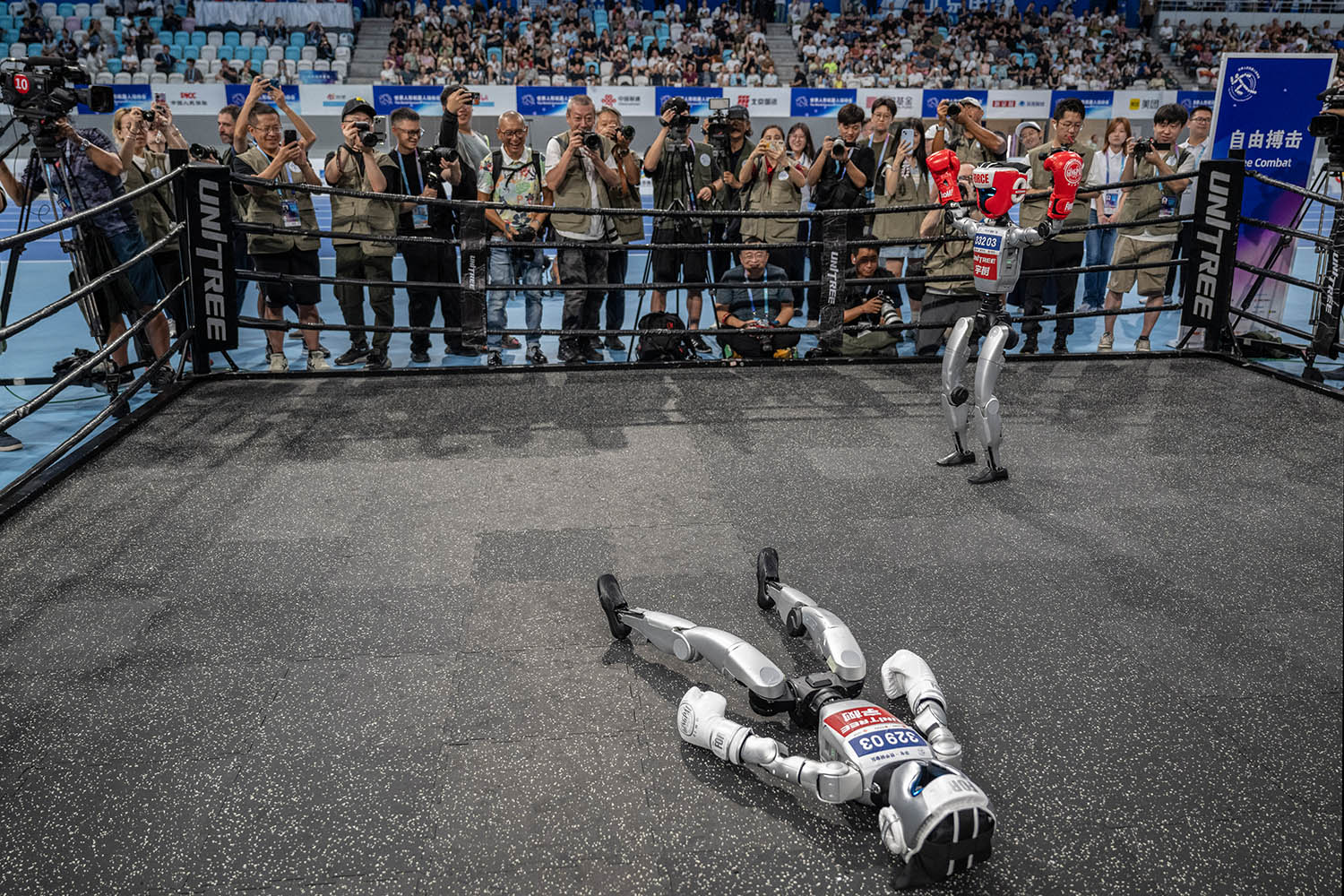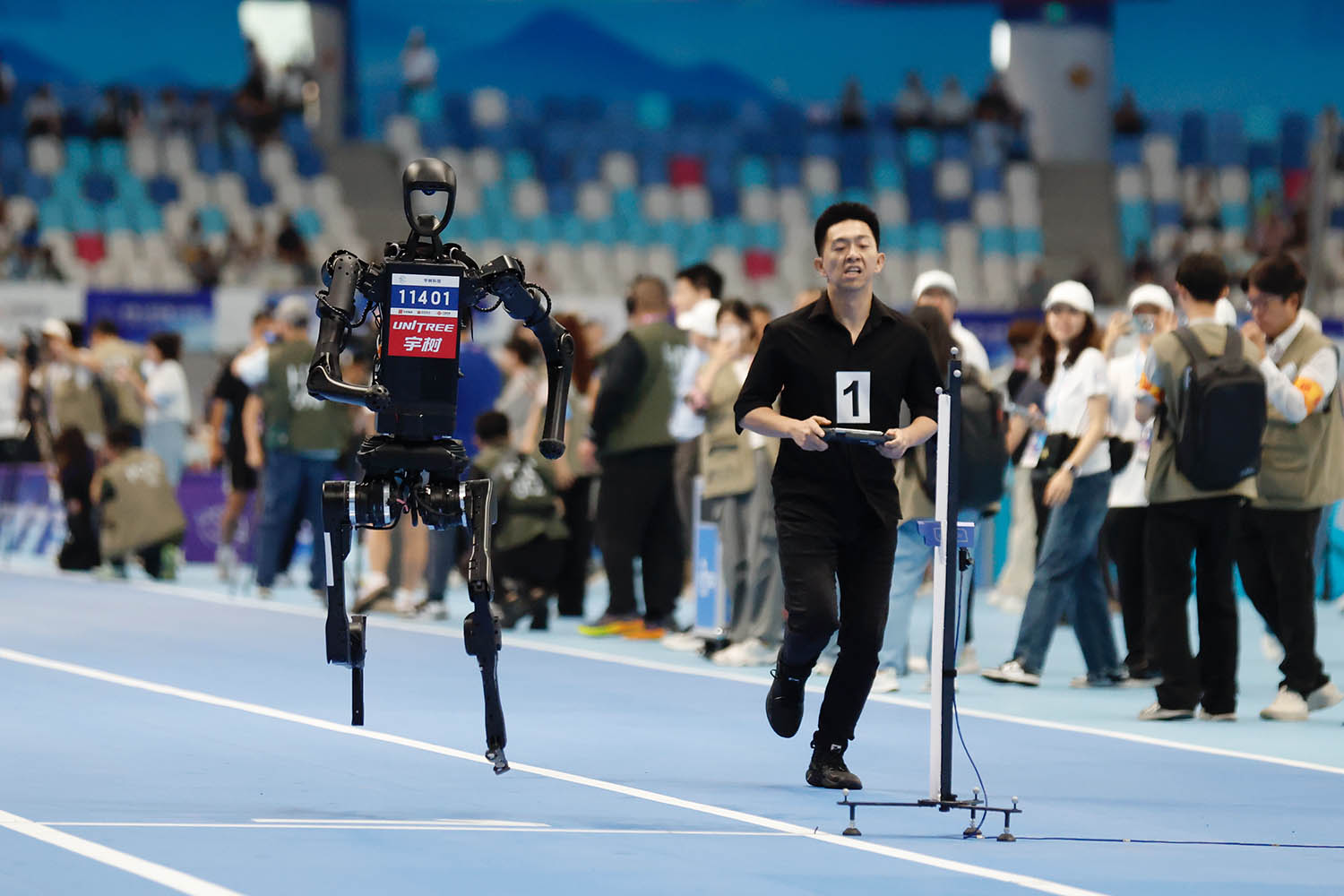Everybody loves a plucky loser. So one of the heroes at the world’s first humanoid games, held in China last week, was a robot called Taishan. It fell over, lost an arm and then got up to complete a 1,500m race with wires dangling from the stump of its shoulder. Taishan was cheered and clapped as it staggered across the finish line.
The World Humanoid Robot Games hosted in Beijing drew 280 teams from 16 countries, the US among them. Chinese companies such as Unitree Robotics and X-Humanoid swept the medal table, excelling in events including running, long jump and kickboxing.
‘The US, Europe and the rest of East Asia are right to fear further [Chinese] deindustrialisation’
Dan Wang, academic
This performance is not merely a curiosity. Humanoid robotics is the latest of several high-tech sectors in which Chinese companies are taking a global lead. The disruptive shock sustained by competitor companies in the west is intensifying – and looks set to become one of the biggest economic themes of the decade, analysts say.
“The US, Europe and the rest of East Asia are right to fear further deindustrialisation,” said Dan Wang, author of a new book, Breakneck: China’s Quest to Engineer the Future.
Wang describes a dynamic in which China has suppressed consumerism in order to channel money into advanced technology industries, creating white-knuckle domestic competition. One upshot of this is an overwhelming impulse to export in order to chase fatter profit margins.
It is early days for humanoid robots. Export volumes are still embryonic. But the potential is clear now that domestic prices of humanoids are falling precipitously, bringing them within reach of wealthy individual consumers for the first time.
Indeed, the new bipedal humanoid robot from Unitree Robotics hit the market in July in China at a retail price of 39,900 yuan (£4,100), a deep saving on the G1 robot launched last year at a starting price of 99,000 yuan. And the new robot, called the R1, is significantly lighter than the 35kg G1.
Such affordability heralds the start of a new era globally. At about £4,000 a pop, humanoid robots could become desirable accessories in fashionable homes, not only in China but subsequently in the west too.
In the care industry, humanoid robots are already finding applications in China. Robot nurse assistants work in hospitals and care homes, while Chinese surgeons have caught up with western telesurgery by using a robotic system to perform operations on a patient in Beijing from thousands of miles away in Lhasa and two other cities.

The movements of the surgeons were translated into data, which was then transmitted through a satellite connection to the robot in Beijing, which in turn worked on the patient’s liver, gallbladder and pancreas, according to official Chinese media.
This robot action is part of an established trend as China vaults to the forefront of global technology. Much less well understood, however, is how its emerging leadership in several technologies will affect the economies of the west and leading western companies.
The auguries do not look good. The first item to consider is how China’s trade performance – in defiance of US efforts to rein it in – has smashed records this year as high-tech products made in China at highly competitive prices flood into Europe, Southeast Asia, Africa and elsewhere.
It looks likely that in 2025 that China’s trade surplus with the world will exceed an unprecedented $1tn US dollars, eclipsing the $992bn it chalked up last year. This prediction is based on the actual $586bn trade surplus that China racked up in the first half of this year, a 34% increase year-on-year.
But more consequential than the headline number is the composition of what China is exporting. In contrast to a decade ago, high-tech products accounted for a modest proportion of total exports to the world. But in the first five months of this year, the broad “equipment manufacturing products” category (which includes robots, electric vehicles, solar panels, wind turbines, ships, telecoms equipment and other high-tech items) accounted for 58% of total exports.
What this means for the world is being called the “China Shock 2.0” reflecting the traumatic blows already being sustained by some of the west’s leading tech corporations from Chinese competition. The high-tech nature of these convulsions marks them as much more consequential than the first China Shock some two decades ago, which was felt mostly by mid-tech manufacturers.
The names of western companies in the frame for disruption reads like a who’s who of manufacturing excellence. Most well-known is the shock that VW, BMW, Mercedes-Benz and others are suffering at the hands of Chinese electric vehicle competitors such as BYD.
But the China Shock is being felt much more widely. Merck, a US pharmaceutical company, announced early this year that it was halting shipments of a vaccine called Gardasil to China, resulting in a sudden 18% decline in global sales. The move came after a local competitor, Wantai BioPharm, began selling a similar drug at a fraction of Merck’s price.
This competitive surge is having repercussions across the globe. The European Central Bank said this month that about 240,000 jobs in the Eurozone had either “ceased to exist” or been shifted to less exposed sectors between 2015 and 2022 as a result of competition from Chinese manufacturers.
The time period covered, however, represents a mere precursor to the stresses now squeezing many of Europe’s best companies.
Photograph by Han Haidan/China News Service/VCG via Getty Images, Kevin Frayer/Getty Images
